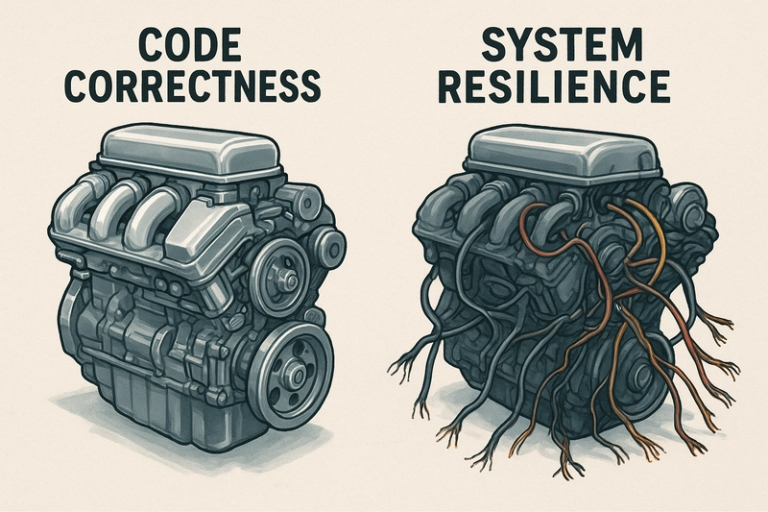Nx vs. Turborepo: Integrated Ecosystem or High-Speed Task Runner? The Key Decision for Your Monorepo
Introduction: The Monorepo “Problem”
In modern software development, monorepos have become a standard solution for managing complexity. Housing multiple applications and libraries in a single repository offers undeniable advantages, though it’s a strategy that must be weighed carefully. (If you’re still debating between a monorepo and a multi-repo, I’ve explored that decision in detail in my article Repository Architecture: Exploring Monorepo, Multi-repo, and Beyond).
Once you commit to a monorepo, it brings a headache that grows over time: speed.
As the project expands, build, test, and linting times skyrocket. Tasks that once took seconds now take minutes (or hours). This is where modern build systems come into play.
Today, two titans dominate this conversation: Nx and Turborepo.
I’ve helped multiple teams scale their projects and have dealt with the consequences of choosing the wrong tool. The truth is, a feature-by-feature comparison doesn’t tell the whole story. This isn’t just a technical decision; it’s a philosophical decision about how you want to manage your workspace and your team.
In this article, we won’t just compare features; we’ll analyze what you are really “buying” with each.
The Fundamental Question: What Are You Buying?
Before looking at the tools, you must decide what problem you’re trying to solve:
- Are you buying speed? Do you want a minimalist task runner that you can add to your existing project to make your scripts fly, without getting in your way?
- Are you buying an ecosystem? Do you want a complete framework that guides you, offers code generators, enforces architectural rules, and helps you manage complexity long-term, in addition to being fast?
Your answer to this question will almost instantly lean you toward one of the two solutions.
🚀 Option A: Turborepo (The F1 Engine)
Turborepo (acquired by Vercel) is a high-performance task runner. Its philosophy is minimalism and pure speed.
It focuses on one thing and does it exceptionally well: understanding the dependencies of your package.json scripts and executing tasks in parallel, aggressively caching the results.
Its configuration is simple, often a single turbo.json file in the root, where you define your pipelines.
✅ The Good: The Speed Argument
- Adoption in Minutes: You can add Turborepo to an existing monorepo (managed with pnpm, yarn, etc.) in under 10 minutes and see immediate speed improvements.
-
Minimalist (Not Intrusive): It doesn’t force you to restructure your project. It’s still “your” monorepo; Turborepo just handles running the scripts defined in your
package.json. - Simple Remote Caching: It integrates natively with Vercel for shared remote caching, which is pure gold for CI pipelines.
⛔ The Critique: Speed Without Direction
Turborepo gives you an incredibly fast car, but it doesn’t give you a map or a seatbelt.
It only solves the problem of execution speed. It doesn’t help you with architecture. It doesn’t stop you from creating circular dependencies, offer generators to create new components consistently, or give you a visualizer for the chaos you might be creating.
The responsibility for architecture, coherence, and best practices falls 100% on your team’s discipline.
🛠️ Option B: Nx (The Construction Kit)
Nx (by Nrwl) is an integrated workspace ecosystem. Speed is just one of its features, not its sole purpose.
Nx’s philosophy is that a healthy monorepo needs more than speed: it needs structure, consistency, and governance. It offers a set of “opinionated” tools to build, test, and deploy your code.
✅ The Good: The Architecture Argument
- Code Generators: Its strongest feature. It allows you to generate applications, libraries, and components with a single command, ensuring they all follow the same structure.
-
Dependency Analysis (
affected): Nx understands your code at a deep level. It can run tasks (like tests) only on the projects that have been affected by your changes. This is much smarter than a simple cache. -
Module Boundaries (Governance): For me, this is its hidden gem. Nx allows you to define architectural rules. For example: “The
frontendapp cannot import code directly from thebackendapp.” This actively prevents technical debt. - Visualization: It includes an interactive visualizer for your project’s dependency graph.
⛔ The Critique: The Price of an Opinion
Nx is “heavy” and “magical.” Its power comes at a cost:
-
Learning Curve: You have to “buy into” the Nx philosophy. It requires a more complex setup (multiple
project.jsonfiles orpackage.jsonconfiguration) and learning its CLI. - Intrusive: Migrating an existing project to Nx is much more complex than adding Turborepo. Nx wants to manage your workspace its way.
- Cognitive Overhead: Sometimes, doing something simple that falls outside the standard generators can be frustrating if you don’t understand how the “magic” works under the hood.
Quick Comparison: Nx vs. Turborepo
| Feature | 🚀 Turborepo | 🛠️ Nx |
|---|---|---|
| Main Purpose | Fast Task Execution | Workspace Management |
| Configuration | Minimalist (turbo.json) |
Detailed (nx.json, project.json) |
| Code Generation | No | Yes (Extensive, plugin-based) |
| Architecture Rules | No | Yes (Module Boundaries) |
| Dependency Graph | No | Yes (Interactive) |
affected Commands |
No (Cache-based) | Yes (Deep Graph Analysis) |
| Adoption Curve | Very Low | Medium / High |
| Best for… | Speeding up existing projects | Starting new, complex projects |
The Verdict: What Should You Choose?
As an experienced software engineer, my answer always goes beyond the tool itself: “It depends on your strategic and team goals.”
➡️ You should choose Turborepo if…
- Your main (and perhaps only) problem is that your CI/CD and local builds are slow.
- You have an existing monorepo and don’t want to perform a costly migration.
- You have a senior, disciplined team that can self-manage architecture without needing tools to enforce it.
- You value minimalism and flexibility over structured guidance.
➡️ You should choose Nx if…
- You are starting a new project and want a solid structure from day zero.
- Your project is large, complex, and needs long-term maintainability.
- You have teams of varying seniority and need tools to ensure consistency and best practices.
- You value architectural governance (avoiding “spaghetti code”) as much as or more than execution speed.
Conclusion (The Dave Stack’s Take)
The choice between Nx and Turborepo defines your project’s trajectory.
- Turborepo is a tactical tool that offers a quick, impressive win.
- Nx is a strategic tool that requires an initial investment but pays dividends in long-term maintainability and scalability.
At The Dave Stack, the approach I want to promote and share is that of building software that not only works today but is sustainable tomorrow. That’s why, for most new and complex projects, I tend to lean towards the governance and structure that Nx provides. In fact, for TypeScript-based projects, Nx has become my go-to tool, as I explain in detail in my article Nx: Why It’s Become My Favorite Tool for TypeScript Projects.
At the end of the day, the right tool is the one that aligns with your team and business strategy.
Now it’s your turn: Nx or Turborepo?
You’ve read my analysis, now I want to know yours. What tool do you use in your day-to-day, and why? Do you value Nx’s governance more, or Turborepo’s minimalist speed?
Share your experience in the comments. The discussion enriches the entire community.




